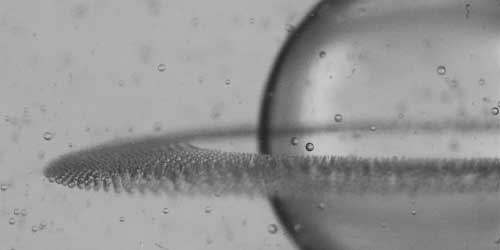| Posted: Jul 27, 2017 |
A new twist on electrosprays
(Nanowerk News) Saturn’s diameter in outer space: 72,367 miles.
|
|
Saturn’s diameter in Petia Vlahovska’s laboratory: one millimeter.
|
|
Although Vlahovska’s Saturn-shaped oil drop might seem far less commanding than their lookalike planet, they are undoubtedly more useful for Earthlings.
|
|
An associate professor of engineering sciences and applied mathematics in Northwestern’s McCormick School of Engineering, Vlahovska developed the otherworldly shaped drops when searching for a process that could quickly generate millions of uniform droplets. The outcome could enable precisely dosed pharmaceuticals, new materials for photonics, printing methods, and more.
|
|
Supported by the National Science Foundation, the research was published recently in the journal Physical Review Letters ("Streaming from the Equator of a Drop in an External Electric Field"). Vlahovska coauthored the paper with Quentin Brosseau, a post-doctoral fellow at New York University.
|
 |
| An electric field can pull apart a millimeter-sized oil drop, causing it to shed thin rings from its equator that then break up into tiny droplets.
|
|
For this project, Vlahovska was inspired by electrosprays, a technique used in mass spectrometry for which American chemist John Bennett Fenn received the 2002 Nobel Prize. When an electric field is applied to a conductive liquid drop, the voltage stretches the drop along its polar axis into a football or lemon shape. The pointed tips at the poles then emit a stream of tiny charged droplets.
|
|
“We wondered if we could make an electrospray with not just one but multiple jets,” Vlahovska said. “Could we make a process in which we can generate millions of droplets at once?”
|
|
Mathematical models suggested that this outcome was possible. But instead of using the conventional conductive liquid, Vlahovska and her team used drops of liquid (silicone oil) submerged in a more electrically conductive fluid (castor oil). When they applied the electric field, the drop first flattened into a lens-like shape. Then the drop became encircled by concentric rings, which broke up to form an array of micro-droplets around the equator. The Saturn-shaped drop eventually transformed into millions of microscopic, uniform-sized beads.
|
|
“The process is ideal because it doesn’t require any fancy, expensive equipment,” Vlahovska said. “You just take the drop, apply the electric field, and poof! You have millions of micro-sized droplets suspended in your medium. In terms of throughput, it has huge potential.”
|
|
Although Vlahovska is still working to fully understand the process, she believes it has potential for many applications. Pharmaceutical development, for example, is just one of several applications that could benefit from the fast creation of uniform-sized droplets.
|
|
“The holy grail for pharmaceuticals is to create small, disperse particles,” Vlahovska said. “You can put a chemical or molecule into a drop, zap it with the electric pulse, and get all these tiny droplets. That is your dosage. Then you just need to package it and send it off.”
|

